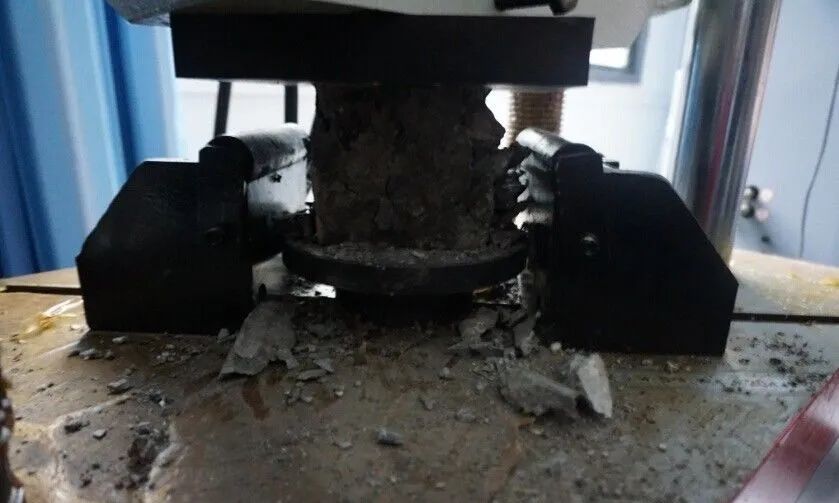Jianjiantong media ID: jianzhong001 the strength of concrete hardly increases from 7 days to 28 days
. 
What’s the matter? The reasons can be roughly divided into the following: 1
. 
Maintenance conditions: whether it meets the requirements? Because the proportion of 7D and 28d is the empirical data obtained under the standard maintenance conditions (constant temperature and humidity), if it is not the standard maintenance conditions, there is no comparison
.
2
.
The additives that affect the proportion of 7D and 28d are early strength agent and excessive retarder
.
3
.
There are also air entraining agents which have influence on the later strength
.
4
.
Cement composition, if the alkali content in cement is too high, it will reduce the late strength
.
5
.
The adaptability of admixture and cement
.
The influence on this kind of cement must be proved by test
.
6
.
Early strength agent is excessive
.
7
.
The surplus strength of cement itself is not high, and the later strength growth rate is small
.
The reason and treatment of the insufficient strength of engineering concrete in the process of concrete compressive strength test: the strength grade of structural concrete must meet the design requirements This is a mandatory provision of the construction specifications, which must be strictly implemented
.
But up to now, there are still some engineering concrete quality problems caused by insufficient strength
.
The results of low concrete strength are mainly manifested in the following two aspects: first, the bearing capacity of structural members decreases; second, the impermeability, frost resistance and durability decrease
.
Therefore, the problem of insufficient concrete strength must be seriously analyzed and dealt with
.
1、 Common reasons for insufficient concrete strength: 1
.
Quality problems of raw materials (1) poor quality of cement (1) low actual activity (strength) of cement: there are two common cases: one is poor quality of cement, and when it is applied in practical engineering, before the 28d strength test results of cement are measured, the cement strength grade is estimated first to configure concrete, when the 28d measured strength of cement is lower than the original estimated value Second, the cement storage condition is poor, or the storage time is too long, resulting in cement caking, activity reduction and affect the strength
.
2) Unqualified cement stability: the main reason is that the cement clinker contains too much free calcium oxide (CAO) or free magnesium oxide (MgO), and sometimes it may be caused by too much gypsum
.
Because the Cao and MgO in the cement clinker are burned, the curing is very slow when it meets with water, and the volume expansion caused by the curing lasts for a long time
.
When the amount of gypsum is too much, gypsum reacts with hydrated calcium aluminate in hydrated cement to form hydrated calcium aluminate sulfate, which also makes the volume expand
.
If these volume changes occur after the hardening of concrete, they will destroy the cement structure, most of them will lead to concrete cracking, and also reduce the strength of concrete
.
In particular, it should be noted that although there are no obvious cracks on the surface of concrete prepared by some cement with poor stability, the strength is extremely low
.
(2) Poor quality of aggregate (sand and stone): 1) low strength of stone: in the pressure test of some concrete blocks, many stones are crushed, which indicates that the strength of stone is lower than that of concrete, resulting in the decrease of actual strength of concrete
.
2) Poor volume stability of stone: some broken stones made of porous chert, shale, limestone with expansive clay, etc., often show poor volume stability under the action of alternate drying and wetting or freeze-thaw cycles, resulting in the decline of concrete strength
.
3) The shape and surface state of stone are bad: the high content of needle flake stone affects the strength of concrete
.
Because of its rough and porous surface, stone has a good combination with cement, which has a favorable effect on the strength of concrete, especially the bending and tensile strength
.
The most common phenomenon is that under the condition of the same cement and water cement ratio, the strength of gravel concrete is about 10% higher than that of pebble concrete
.
4) The content of organic impurities in aggregate (especially sand) is high: for example, the aggregate contains organic impurities such as rotten animals and plants (mainly tannic acid and its derivatives), which have adverse effects on cement hydration and reduce the strength of concrete
.
5) High content of clay and dust: the decrease of concrete strength caused by this reason is mainly manifested in the following three aspects: first, these very fine particles are wrapped on the surface of aggregate, affecting the bond between aggregate and cement; second, increasing the surface area of aggregate, increasing water consumption; third, clay particles and volume are unstable, dry shrinkage and wet expansion, which have a certain destructive effect on concrete
.
6) High content of sulfur trioxide: the aggregate contains sulfide or sulfate such as pyrite (FeS2) or gypsum (CaSO4 · 2H2O)
.
When the content of sulfur trioxide is high (e.g
.
> 1%), it may react with the hydration of cement to produce calcium sulphoaluminate, resulting in volume expansion, leading to cracks and strength reduction of hardened concrete
.
7) High mica content in sand: due to the smooth surface of mica, poor bonding performance with cement paste and easy cracking along joints, the high mica content in sand has adverse effects on the physical and mechanical properties (including strength) of concrete
.
(3) If swamp water with high content of organic impurities, sewage containing humic acid or other acids and salts (especially sulfate) and industrial waste water are used to mix concrete, the physical and mechanical properties of concrete may decline
.
(4) The quality of admixtures is poor
.
At present, the unqualified quality of admixtures produced by some small factories is quite common
.
Due to the lack of concrete strength caused by admixtures, even the concrete does not set accidents occur from time to time
.
2
.
Improper concrete mix proportion is one of the important factors to determine the strength of concrete
.
The water cement ratio directly affects the strength of concrete, and other factors such as water consumption, sand ratio and bone cement ratio also affect various properties of concrete, resulting in insufficient strength accidents
.
In engineering construction, these factors are generally shown in the following aspects: (1) mix proportion is applied at will: the mix proportion of concrete is determined after the site applies to the laboratory for trial mix according to the engineering characteristics, construction conditions and raw materials
.
However, many construction sites, regardless of these specific conditions, just according to the index of concrete strength grade, arbitrarily apply the mix proportion, resulting in many accidents of insufficient strength
.
(2) Increase in water consumption: the more common ones are inaccurate measurement of water adding device on mixing equipment; not deducting the water content in sand and gravel; and even adding water arbitrarily at the watering place
.
With the increase of water consumption, the water cement ratio and slump of concrete increase, resulting in the accident of insufficient strength
.
(3) Insufficient cement consumption: in addition to inaccurate measurement before mixing, insufficient weight of packaged cement also occurs frequently, resulting in insufficient cement consumption in concrete and low strength
.
(4) Inaccurate measurement of sand and stone: the more common ones are old measuring tools or poor maintenance and management, and unqualified accuracy
.
(5) There are mainly two kinds of wrong admixtures: one is the wrong variety
.
Before we know the early strength, retarding and water reducing properties of admixtures, we blindly mix admixtures, which leads to the concrete not reaching the expected strength; the other is the wrong amount of admixtures
.
Test and examination review data plus wechat: 17507557988 (6) alkali aggregate reaction: when the total alkali content of concrete is high, coarse aggregate containing carbonate or active silica (aggregate made of opal, chalcedony, obsidian, zeolite, porous chert, rhyolite, andesite, tuff, etc.) is used, which may produce alkali aggregate reaction, that is, alkaline oxide hydrolysis The sodium hydroxide and potassium hydroxide react with the active aggregate to form a continuous hydrogel, which causes the concrete to crack or decrease in strength
.
According to the information in Japan, under the same conditions, the concrete strength after alkali aggregate reaction is only about 60% of the normal value
.
3
.
Problems in concrete construction technology (1) poor mixing of concrete; the order of adding materials to the mixer is reversed, and the mixing time is too short, resulting in uneven mixture and affecting the strength.
.




